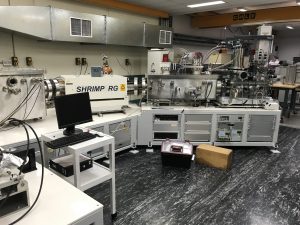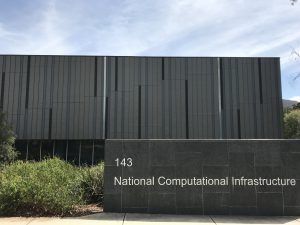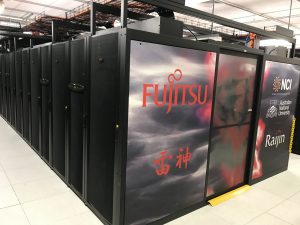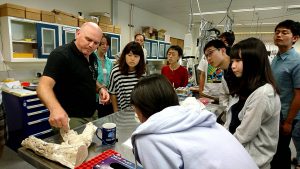General report of the AUS field trip/国際研修Iレポート Day 2 (28 Feb. 2019)
In the second day of the trip, we received several lectures in Research School of Earth Sciences of ANU after a warm briefing of Dr. David Heslop. In the first lecture by Dr. John Mavrogenes regarding Australian geological settings. We learned about the key components that makes up the continent: the Yilgarn Craton in the Southwest where iron-rich sediments layers can be found, and the Lachalan Fold belt in the Southeast seen turbidite of over 1000 km thick. The latter can be attributed to accordian tectonics, which is caused by re-closure of backarc basin related to slab rollback. Dr. Mavrogenes also mentioned the Homelin Pool, where currently-living Stromatolites from 3.2 billion years ago is protected by the 10% salinity environment. We are interested by the drop stones, where evidences of movement of glaciers into the ocean can be proved by the appearance of large granite pebbles in mud formations.
We then were introduced to space missions and their observations by Dr. Trevor Ireland. Samples taken from asteroids Itokawa by spaceship Hayabusa and Ryugu by Hayabusa 2 are analyzed for better understanding of composition of the surface and deeper structures of asteroids. After the lecture, we visited the SHRIMP (Sensitive High Resolution Ion Microprobe), which allows focused dating of small pieces of samples. Ions of oxygen or cesium are shot at target region, ionize materials from the sample, and can be differentiated using the mass-to-charge ration. After the exciting tour to the SHRIMP apparatus, Dr. Rhodri Davies brought about several geodynamic studies, including plate evolution simulation accounting for mantle convection that solves balances of forces, conservations of mass and energy in parallel. Intraplate volcanic activities attributed to plumes can be observed in the surface through hotspots, e.g. the sea-mount chain of Hawaii.


After a series of stimulating lectures, we enjoyed an Australian-traditional BBQ provided by ANU students!

After the lunch, we went for a short tour in NCI, the National Computation Infrastructure, where computation and storage space are provided to ANU and other research facilities. Raijin is the outcome of cooperation of various companies including Fujitsu. It weights 70 tons and consumes 3000 litters of water in an hour for cooling. After returning to the Research School of Earth Sciences, Dr. Stewart Fallon brought to us the usage of radiocarbon to understand time. 14C dating is shown very effective for matters within 50,000 years; yet requiring calibration due to environmental changes as well as nuclear explosions. In the lab tour following the lecture, we saw the sample of the longest-living animal, the Deep Sea Black Corals, which has been alive for 4000 years before taken as sample. In the last lecture of the day by Dr. Jochen Brocks, we were amazed by research using biomarkers, which, for one instance, extended the records of animal activities far long before fossil records.Early evolution of animals between two snowball Earth periods coinciding with boom of algae is confirmed by the speaker’s group. In the lab tour before the end of the lecture, we learnt about the care the study group paid to not include carbohydrates in the labs, going as far as to using glass containers for all purposes.





